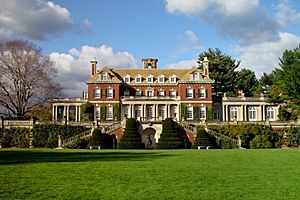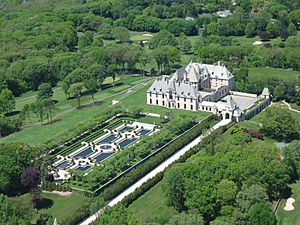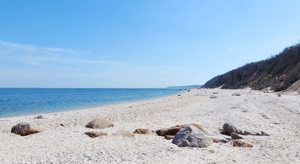North Shore (Long Island) facts for kids
The North Shore of Long Island is the area along the northern coast of New York's Long Island bordering Long Island Sound. Known for its extreme wealth and lavish estates, the North Shore exploded into affluence at the turn of the 20th century, earning it the nickname the Gold Coast. Historically, this term refers to the coastline communities in the towns of North Hempstead and Oyster Bay in Nassau County and the Town of Huntington in Suffolk County, although the town of Smithtown east of here is also known for its affluence. The easternmost Gold Coast mansion is the Geissler Estate, located just west of Indian Hills Country Club in Fort Salonga, within the Town of Huntington.
Being a remnant of glacial moraine, the North Shore is somewhat hilly, and its beaches are more rocky than those on the flat, sandy outwash plain of the South Shore along the Atlantic Ocean. Large boulders known as glacial erratics are scattered across the area.
Contents
History
Colonial Era
The North Shore was first settled in the mid-1600s. Much of the area was initially controlled by the Dutch colony of New Netherland. Towns in the eastern part of the North Shore were settled by the English under the jurisdiction of the New Haven Colony and Connecticut Colony. This arrangement ended in 1664 with the English takeover of New Netherland, when all of Long Island was transferred into the new Province of New York.
In its early days the North Shore was largely agricultural. Whaling was also a component of the early economy, as is commemorated in Cold Spring Harbor's Whaling Museum & Education Center.
Gilded Era
During the Second Industrial Revolution, great fortunes were made in steel, transportation and other industries. Beginning in the early 1890s, lavish private estates were erected on what became known as the "Gold Coast" of Long Island. In all, over 500 mansions were built during this spree, concentrated in 70 square miles (180 km2).
Among those were expansive faux chateaux and castles belonging to the Vanderbilts, Astors, Whitneys, Charles Pratt, J. P. Morgan, F. W. Woolworth, and others. Otto Kahn's Oheka Castle was reputed to be the second largest private home in the United States, second only to the Biltmore Estate in Asheville, North Carolina. Alternatively, some eschewed formal mansions and erected large shingle-style and clapboard "cottages", such as Theodore Roosevelt's Sagamore Hill.

The greatest architects, landscapers, decorators and firms were employed, including Stanford White, John Russell Pope, Guy Lowell, and Carrère and Hastings. Architectural styles included English Tudor, French Chateau, Georgian, Gothic, Mediterranean, Norman, Roman, Spanish, and combinations of these. Rooms, outdoor structures, and entire buildings were dismantled in Europe and reassembled on the North Shore. Complimenting the great houses were formal gardens, gazebos, greenhouses, stables, guest houses, gate houses, swimming pools, reflecting pools, ponds, children’s playhouses, pleasure palaces, golf courses, and tennis courts. Activities such as horse riding, hunting, fishing, fox hunting, polo, yachting, golf, swimming, tennis, skeet shooting and winter sports, were held at the estates or exclusive clubs nearby such as the Beaver Dam Club, the Seawanhaka Corinthian Yacht Club (1871), Meadow Brook Club (1881), Manhasset Bay Yacht Club (1892), Piping Rock Club (1912), and Creek Club (1923). Privacy was maintained with the huge land holdings, hedges and trees, fences, gates and gate houses, private roads, and lack of maps showing the location of the estates.
Post-War era
Following World War II many Gold Coast mansions were demolished and their estates subdivided into suburban-style developments. Only about 200 of the original 500 survive. As fortunes faded some of the largest or most prominent Gilded Era showpieces, such as Daniel Guggenheim's Gould-Guggenheim Estate, Theodore Roosevelt's Sagamore Hill, William Vanderbilt II's Eagle's Nest, the Alexander P. de Seversky Mansion, Otto Kahn's Oheka Castle, and John Shaffer Phipps' Westbury House were turned into museum homes, conference centers, and resorts. Others repurposed for non-residential uses include Herbert L. Pratt's Glen Cove country home, "The Braes", turned into the Webb Institute, Walter Chrysler's Kings Point estate, "Forker House", turned into the United States Merchant Marine Academy, and U.S. Steel heir Childs Frick's "Clayton" the Nassau County Museum of Art.
Geography
Delineated perceptually by the Queens-Nassau border, the North Shore is marked by a series of necks (peninsulas) and populated harbors. North Hempstead, Oyster Bay and Huntington Towns comprise the land ownership of this area, which is noted for its preservation of Gilded Age Estates. Beyond here, the North Shore becomes Towns of Smithtown and Brookhaven, where a similar trend of peninsulas and sheltered harbors are the sites of hamlets and towns such as Stony Brook, Port Jefferson, Wading River, etc..
Once the island splits into two forks at its east end, the North Shore's hills largely flatten out (and enter the Town of Riverhead) to an out-wash plain and becomes largely rural (and enters the Town of Southold), with an economic stronghold on agriculture, particularly in the shape of wineries and vineyards. This recent trend, beginning in the 1980s with the conversion of potato farms, has given the North Fork the distinction of being the most productive agricultural area in New York State. Despite this, North Fork, contrasts starkly with the more populated and more well-known South Fork's Hamptons. The North Fork terminates at Orient Point, where the Cross Sound Ferry Company has a terminal for ferries bound for New London, CT. and Block Island, RI.
Greenport, a village in Southold midway between Orient and Riverhead, is a major economic center for the North Fork and as such, is the eastern terminus of the Long Island Rail Road's Main Line. The North Fork is also geographically tied to a separate township, Shelter Island, an island in the Peconic Bay accessible via ferry that leaves from Greenport, adjacent to the railroad station. The island also has a ferry on its south side that connects with North Haven on the South Fork.
Extant Gold Coast estates
- Caumsett, formerly the Marshall Field III Estate
- Coindre Hall
- Delamater-Bevin Mansion
- Greentree
- Harry E. Donnell House
- Hempstead House
- John E. Aldred Estate
- Killenworth
- Nassau County Museum of Art, formerly The Clayton Estate
- Oheka Castle
- Old Westbury Gardens
- Vanderbilt Museum
- Webb Institute, formerly The Braes
- Welwyn Preserve, formerly the Welwyn Estate
- United States Merchant Marine Academy, formerly Forker House
Demolished mansions
Some mansions burned down, others that were abandoned were vandalized or overtaken by vegetation. Many were torn down to make room for developments, as the Great Depression, poor financial decisions, increasing requirements for upkeep, and increasing income taxes depleted family fortunes. Some of the notable mansions that are now gone are included in the table below with some of their features.
| Mansion | Construction | Rooms | Acres | Architects | Status | Location |
|---|---|---|---|---|---|---|
| Beacon Towers | 1917–1918 | 60 | 18 | Hunt & Hunt | demolished 1945 | 40°51′53″N 73°43′40″W / 40.86472°N 73.72778°W |
| Burrwood | 1898–1899 | 40+ | 1,000 | Carrère and Hastings | demolished 1995 | 40°53′1″N 73°28′12″W / 40.88361°N 73.47000°W |
| Farnsworth | c. 1914 | 50 | Guy Lowell | demolished 1966 | 40°51′50″N 73°33′58″W / 40.86389°N 73.56611°W (stable and garage) | |
| Ferguson Castle | 1908 | 40 | Allen W. Jackson | demolished 1970 | 40°53′39″N 73°25′6″W / 40.89417°N 73.41833°W (gate house) | |
| Garvan | 1891 | 60 | 101 | demolished mid-1970s | 40°47′59″N 73°36′4″W / 40.79972°N 73.60111°W | |
| Harbor Hill | 1900–1902 | 688 | Stanford White | demolished Spring 1947 | 40°47′57″N 73°38′1″W / 40.79917°N 73.63361°W | |
| Inisfada | 1920 | 87 | 225 | John Torrey Windrim | demolished December 2013 | 40°47′07″N 73°39′59.2″W / 40.78528°N 73.666444°W |
| Laurelton Hall | 1902–1906 | 65 | 600 | Louis Comfort Tiffany | burned down 1957 | 40°52′22″N 73°29′1″W / 40.87278°N 73.48361°W |
| Matinecock Point | 1913 | 41 | 257 | Christopher Grant La Farge | demolished 1980/1981 | 40°53′59″N 73°37′53″W / 40.89972°N 73.63139°W |
| Meudon | c. 1900 | 80 | 300 | Charles P.H. Gilbert | demolished 1955 | 40°53′51″N 73°36′15″W / 40.89750°N 73.60417°W |
| Pembroke | 1914–1916? | 82 | 62 | Charles P.H. Gilbert | demolished 1968 | 40°52′21″N 73°39′11″W / 40.87250°N 73.65306°W |
| Rosemary Farm | 1907 | 159 | William Eyre | burned down 1991 or 1992 | 40°54′25″N 73°28′38″W / 40.90694°N 73.47722°W | |
| Roslyn House | 1891 | James Brown Lord | demolished 1974 | 40°47′55″N 73°36′43″W / 40.79861°N 73.61194°W | ||
| Westbrook Farms/Knollwood | 1906–1920 | 60 | 262 | Hiss & Weekes | demolished 1959 | 40°49′33″N 73°32′11″W / 40.82583°N 73.53639°W |
Cities, villages, neighborhoods, and hamlets
- Asharoken
- Bayville
- Belle Terre
- Brookville
- Centerport
- Centre Island
- Cold Spring Harbor
- Commack
- Cove Neck
- East Norwich
- East Hills
- East Setauket
- Eatons Neck
- Flower Hill
- Fort Salonga
- Glen Cove
- Glen Head
- Great Neck
- Great Neck Estates
- Greenport
- Halesite
- Head of the Harbor
- Huntington
- Huntington Bay
- Jericho
- Kensington
- Kings Park
- Kings Point
- Lake Success
- Lattingtown
- Laurel Hollow
- Locust Valley
- Lloyd Harbor
- Manhasset
- Matinecock
- Mattituck
- Mill Neck
- Mount Sinai
- Muttontown
- Nissequogue
- North Hills
- Northport
- Oyster Bay
- Oyster Bay Cove
- Old Brookville
- Old Field
- Old Westbury
- Orient
- Plainview
- Plandome
- Plandome Manor
- Poquott
- Port Jefferson
- Port Washington
- Rocky Point
- Roslyn
- Roslyn Estates
- Roslyn Harbor
- Roslyn Heights
- Saddle Rock
- Sands Point
- Sea Cliff
- Setauket
- Shoreham
- Smithtown
- Southold
- Stony Brook
- Syosset
- Thomaston
- Upper Brookville
- Wading River
Images for kids
-
The demolished Beacon Towers estate, along with Oheka Castle, has been identified as an influence for the novel The Great Gatsby



